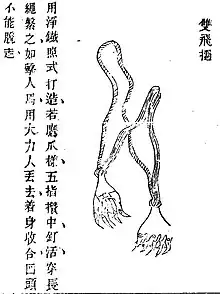
The flying claw, flying talon, or soft talon (Chinese: 飛爪; pinyin: fēizhuǎ / fēizhǎo) is used to ensnare a foe and throw him off balance. It originated in China during the Sui dynasty and is one of the flexible or soft weapons in the Chinese martial arts. It features metal hand or claw on the end of a chain or rope. It is in the same family as the meteor hammer, rope dart, and chain whip.
It is designed to wrap, capture, entangle and grip. Some are more elaborate and the claw actually closes and tightens when the rope/chain is pulled. Those are constructed with a spring mechanism within the metal claw that allows the claw to open and close as the tether is pulled or released. Some of the latter can grab trees and rip off the bark.[1]
The flying claw varies in reach and chain/rope length. Length of the chain or rope can be up to 15 m (49 ft).
A mace variant of the weapon existed, called an iron claw (Chinese: 挝; tiē zhǎo), where the (opened) claw is not attached to a chain or rope but to a handle. It should not be confused with the iron fist (Chinese: 鐵拳; pinyin: tiěquán) which has a closed claw or fist design for the head of the weapon.[2]
In popular culture
- The flying claws appear in the kung fu film Tiger & Crane Fists. The footage was later used in the comedy film Kung Pow! Enter the Fist.
See also
References